PRODUCTS AND HAZARDOUS PHENOMENA
The principal products of volcanic eruptions may be grouped into several broad categories according to the type of material ejected and its mode of transport from the vents to its place of deposition : ash, falls, pyroclastics flows, lava flow and gas emission. Several other hazardous phenomena are directly associated with eruption. There are ground fracture, ground subsidence, debris avalanche, lahars, glacier bursts, volcanic earthquakes and tsunamis.
TYPES OF VOLCANIC HAZARDS
1 - Lava flows are less dangerous to human life than to property, traffic, and communication because probable path, of lava flows can be roughly predicted, diversion measures, cool advancing front with water, or disruption of source or advancing front of lava flow by explosives may be taken in principle: however, such measures, often turn out to not be very successful. Highly viscous lava generallly does not advance far, but commonly piles, up above an active vent as a lava dome. Such domes can collapse repeatedly and generate dangerous hot block and ash flows and hot surges and blasts.
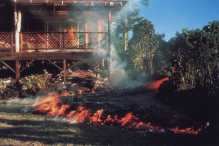
|
Kilauea
lava flows.( V.Clavel)
|
2 -Poisonous, even lethal, gases can be ejected during the eruption of a volcano or can be released without a triggering eruption (e.g. Nyos). The gases are transported away from vent as acid aerosols, as compunds absorbed on tephra and as microscopic salt particles. Sulfur compounds, chlorine and fluorine react with water to form poisonous acids damaging to the eyes, skin and respiratory systems of animals even in small concentrations. Most volcanic gases are noxious and smell bad, but they can cause mass fatalities. The time available for early warning of gas release is extremely short, and intensified investigation on such gas eruption, as well as keen observation of the respective locations, are absolutely necessary.
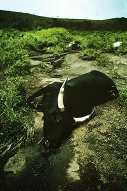
|
Gas
Nyos effect (J.Lockwood)
|
3 - Ashfalls during volcanic eruption generally do not directly endanger life, although the collapse of roof and houses under the ash load are not uncommun. Considerable damage may be caused, however, for agriculture and industry even at distances up to tens of kilometers from a vent. Many of the hazards of tephra falls can be mitigated with proper planning and preparation. This includes clearing tephra from roofs as it accumumulates, designing roofs with steep slopes, strengthening roofs and walls, designing filters for machinery, wearing respirators or wet clothes over the mouth and nose.
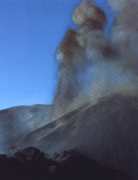
|
Cinder
emission at Fogo (H.Gaudru)
|
4 - Pyroclastic flows and low-density surges that are frequently associated with blast are extremely hazardous types of volcanic eruptions. Pyroclastics flows consist of a mixture of volcanic gases and ash and are generated during many volcanic eruptions. Some may be as hot as 900°C ; they move switfly with velocities of up to several 100 m/s. Early warning for this volcanic phenomenon is virtually impossible. A most dangerous situation develops if pyroclastic flows are generated on snow or glacier covered volcanoes, causing the cover to melt. The only effective method of risk mitigation is evacuation prior to such eruption from areas likely to be affected by pyroclastic flows.
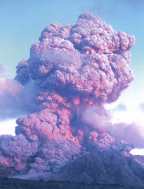
|
Pyroclastics
flows -Soufriere of Montserrat (H.Gaudru )
|
5 - Lahars ( volcanic mud and debris flows) are a common major volcanic hazard for people and property. Lahars likewise proceed very quicky and possess great destructive power. They develop either as a direct consequence of a volcanic eruption, if , for instance, crater lake are blown out, or as a secondary event as a result of heavy rainfall during or after the eruption. Areas farther away may be warned several hours in advance. A sufficient monitoring of individual volcanoes, however, rarely is guaranteed. Small lahars can be diverted by barriers or by artificial channels which lead them away from valuable land or property, but in most cases the volume and force of the lahar is such that it beyond human power to control.
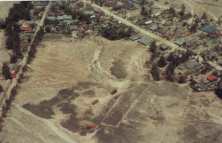
| Lahars of Pinatubo - Philippines- (Y. Miller) |
6 -Volcanic debris avalanches generated by sliding of larger portions of volcanic cones are common. These avalanches are highly mobile and may not only bury large tracts of land and dam stream to form lakes than can drain catastrophically and generate lahars and flooods but also cause devasting tidal waves ( tsunamis) if they advance into lakes or the sea. The only effective method of risk mitigation is evacuation prior to such debris avalanche or tsunamis ( if expecting) from areas likely to be affected by this kind of phenomena.
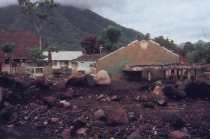
|
Api
Siau Island (V. Clavel)
|
Damage and hazard to human life, social structure, and property may not be induced only by direct effects of volcanic eruptions. Some of the most dangerous secondary phe-nomena are tsunamis, contaminated (e.g., fluorine-rich) ashes, or long-Iasting aerosol clouds that can orbit the Earth for years after large volcanic eruptions. Aerosol clouds basically consist of condensed volcanic gases, mainly sulfuric acid. The emission of large quantities of SO2 and also possibly halogens into the stratosphere may lead to a temperature decrease on the Earth's surface by increasing the global albedo and also can contribute significantly to the destruction of the stratospheric ozone layer. The correlation between volcanic hazards, destructive potential, and the erupted mass is not universal. In many cases, the destructive potential depends less on the mass and temperature of the erupted material than it does on the specific environment of the eruptive center, especcially the degree of magma-water interaction and the energy of the initial blasts.
PREDICTION OF VOLCANIC ERUPTIONS
The development of methods to predict volcanic eruptions is extremely important to provide for early evacuation of densely populated regions. Hazard and risk potential of volcanoes can be localized reasonably well, unlike some other types of natural disasters (earthquakes, storms). Reliable predictions, to a minimum degree, however, are only possible for volcanoes that are well studied and sufficiently instrumented. A prediction based on the statistics of previous eruptions is too vague for specific and short -term prediction of an eruption. A forecast is a general announcement that a volcano will probably erupt in the near future (e.g., by qualitative signs of unrest). A prediction is a relatively precise statement that describes the part of a volcano that is likely to erupt, the time of the eruption, and the presumable type of eruption. Such predictions must be made public with utmost caution in order to gain credibility within the concerned population, thus enabling adoption of preparedness measures. Our increasing understanding of processes inside volcanoes and their measurable effects put predictions more and more on a deterministic basis. The careful analysis of the history of a vol-cano is the most important method in assessing the long-term probability of the occurrence of a specific eruption type and its eruptive energy. Volcanic eruptions are often announced years, months, days, or hours before (e.g., by harmonic tremors in the deeper conduit system). This microseismic activity commonly increases prior to an eruption and is characterized by relatively constant amplitudes and wave lengths that are possibly caused by the turbulent motion of the magma ascending to the surface from a magma chamber. The relatively slow ascent of viscous magma to the upper crust generates a surface expansion that can be measured with modern geodetic instruments. Temperature increases within a volcano as a result of ascending magma can be detected by infrared signals via satellite. Heat conductivity and the magnetic field are changing. An increase of SO2 emission, often has been observed before eruptions. The characteristic behavior of a volcano can be identified with the help of intensive monitoring by satellite.

Seismicity and geochemistry are two of the technics for monitoring active volcanoes
PREVENTION AND MITIGATION OF VOLCANIC HAZARDS
To prevent future disasters, or at least to reduce their extent, a series of measures must be taken before, during, and after a volcanic eruption. Various regional research centers-especially in Latin America and South East Asia-should be established that have archives containing all relevant material and that can serve as centers for training of volcanologists, for public education, and for cooperation with other scientific institutions. The preparation of hazard maps helps to determine whether a volcano is potentially hazardous and to assess the risk. For that purpose, detailed knowledge about the history and characteristics of the specific volcano is indispensable, which requires, among other things, topographic and geologic mapping. Hazard maps show the pathways of eruption products to be ex-pected (such as lava flows or pyroclastic flows) for various eruption intensities. Monitoring of volcanoes by satellites has to increase in order to detect possible changes (e.g., temperature or SO2 emission). Continuous monitoring is essential. When a volcano has been identified as potentially dangerous, ground monitoring (visual and instrumental) should be ensured. The public must be informed and educated on the results of volcanological studies and any possible dangers. This can be done through the use of brochures, lectures, or courses. For potentially dangerous volcanic regions, emergency plans must be worked out, particularly evacuation plans for the population in case of immediate danger. Disaster prevention exercises, as already carried out in Japan, are useful as well.
A volcanic eruption can not practically influenced by man. There are, however, limited possibilities to controlling several of its effects, such as barriers against lava flows or cooling lava with sea water. Smaller lahars can be channeled by artificial sabo dams. Another possibility to prevent the generation of lahars is artificial draining of crater lakes. Long-term regional planning can significantly reduce the hazard potential. Disaster reduction measures can contribute to mitigate the impact of the volcanic eruptions. Fatalities and economic losses can be reduced if, associated with a well monitoring system, including Early Warning and land use planning, a culture of prevention is introduced within all levels of the society.
H. Gaudru - International Commission on Mitigation of Volcanic Disasters - IAVCEI
* SVE Book about volcanic Risk Mitigation ( In french)
** United Nations International Strategy for Disasters Reduction ( ISDR)